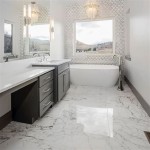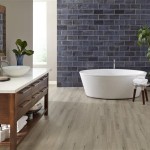Exploring Dynamic Wall and Floor Tile Combinations for Interior Design
The selection and combination of wall and floor tiles are crucial elements in interior design, influencing the aesthetic appeal, functionality, and overall ambiance of a space. Harmonious and well-considered tile pairings can significantly enhance the visual perception of a room, contributing to its perceived size, brightness, and style. Conversely, poorly chosen combinations can lead to a disjointed or unappealing result. This exploration delves into the key considerations and principles involved in crafting effective wall and floor tile combinations, providing insights into achieving aesthetically pleasing and practically sound interior spaces.
Understanding the Impact of Color and Pattern
Color and pattern are fundamental aspects of tile selection, playing a vital role in establishing the atmosphere of a room. The strategic use of color can dramatically alter the perceived dimensions of a space. Lighter colors tend to make a room appear larger and brighter by reflecting more light, while darker colors can create a sense of intimacy and warmth. The careful application of these principles can be utilized to address specific spatial challenges, such as making a small bathroom feel more open or making a large living room feel more cozy.
Similarly, patterns can add visual interest and personality to a room. Large-scale patterns can be impactful and bold, best suited for larger spaces where they can be fully appreciated without overwhelming the area. Smaller, more intricate patterns can add subtle texture and detail, working well in smaller rooms or as accent features. The choice of pattern should also consider the overall style of the space, ensuring that it complements the existing décor and furniture.
When combining wall and floor tiles, it is important to consider the interplay of colors and patterns. A common approach is to use a neutral floor tile as a foundation and then introduce color and pattern on the walls. This allows for greater flexibility in updating the walls without needing to replace the entire floor. Another popular strategy is to use complementary colors for the wall and floor tiles, creating a sense of visual harmony. Alternatively, contrasting colors can be used to create a more dramatic and dynamic effect.
Furthermore, the finish of the tile should be considered in conjunction with color and pattern. Glossy tiles reflect more light and can enhance the brightness of a room, but they can also be more prone to showing scratches and watermarks. Matte tiles offer a more subtle and natural look, providing better slip resistance and concealing imperfections. The choice of finish should be based on both aesthetic preference and practical considerations, taking into account the specific use of the space and the level of traffic it will receive.
Exploring Texture and Material Variation
Beyond color and pattern, texture and material play a significant role in creating visually appealing and tactilely engaging spaces. The interplay of different textures can add depth and dimension to a room, preventing it from feeling flat or monotonous. Combining smooth, polished tiles with rough, textured tiles can create a stimulating contrast that draws the eye and enhances the overall sensory experience. This can involve combining ceramic tiles with natural stone, glass mosaics, or textured porcelain tiles.
The choice of material also influences the aesthetic properties of a space. Ceramic and porcelain tiles are versatile and durable options, available in a wide range of colors, patterns, and textures. Natural stone tiles, such as marble, granite, and slate, offer a luxurious and timeless appeal, adding a sense of sophistication and elegance to any room. However, natural stone tiles may require more maintenance than ceramic or porcelain tiles, as they are more porous and susceptible to staining. Glass tiles provide a sleek and modern aesthetic, reflecting light and adding a touch of glamour to the space. They are particularly well-suited for backsplashes and accent walls.
When combining different materials, it is important to consider their compatibility and how they interact with each other. For example, combining a rustic natural stone floor with sleek glass tiles on the walls can create a striking contrast between the organic and the modern. Alternatively, using different shades of the same material can create a more subtle and cohesive look. It is also important to consider the maintenance requirements of each material, ensuring that they are compatible and that the cleaning and care regimen is appropriate for both types of tiles.
Furthermore, the size and shape of the tiles can contribute to the overall texture and visual interest of a space. Large format tiles can create a seamless and contemporary look, minimizing grout lines and making a room feel more spacious. Smaller mosaic tiles can add intricate detail and texture, creating a more decorative and personalized feel. The choice of tile size and shape should be based on the overall design aesthetic, the size of the room, and the desired level of visual impact.
Considering Functionality and Practicality
Aesthetically pleasing tile combinations are only successful if they also meet the functional requirements of the space. The intended use of the room, the level of traffic it will receive, and the potential for moisture exposure should all be carefully considered when selecting wall and floor tiles. For example, bathrooms and kitchens require tiles that are water-resistant, slip-resistant, and easy to clean. High-traffic areas, such as hallways and entryways, require durable tiles that can withstand wear and tear.
The slip resistance of floor tiles is particularly important in areas where there is a risk of slipping, such as bathrooms, kitchens, and entryways. Tiles are rated for slip resistance using a variety of scales, such as the Coefficient of Friction (COF) and the Dynamic Coefficient of Friction (DCOF). It is important to choose tiles with a slip resistance rating that is appropriate for the intended use of the space. For example, bathrooms and kitchens should have tiles with a higher slip resistance rating than living rooms or bedrooms.
The ease of cleaning and maintenance is another important consideration, particularly in areas where there is a high potential for spills and stains. Ceramic and porcelain tiles are generally easy to clean and maintain, while natural stone tiles may require more specialized cleaning products and techniques. The choice of grout can also affect the ease of cleaning, as some types of grout are more porous and susceptible to staining than others. Epoxy grout is a popular choice for bathrooms and kitchens because it is non-porous and resistant to stains and mildew.
In addition to slip resistance and ease of cleaning, the durability of the tiles is also an important consideration, particularly in high-traffic areas. Tiles are rated for durability using the Porcelain Enamel Institute (PEI) rating system, which ranges from PEI 1 (suitable for light residential use) to PEI 5 (suitable for heavy commercial use). It is important to choose tiles with a PEI rating that is appropriate for the intended use of the space. For example, hallways and entryways should have tiles with a higher PEI rating than bedrooms or bathrooms.
Finally, it is important to consider the overall budget when selecting wall and floor tiles. Tile prices can vary widely depending on the material, size, shape, and pattern. It is important to establish a budget before beginning the selection process and to choose tiles that fit within that budget. It is also important to factor in the cost of installation, which can vary depending on the complexity of the project and the experience of the installer. Obtaining quotes from multiple installers can help to ensure that the installation costs are competitive.

Tried And True Wall Floor Tile Combinations The Shop

Top 10 Color Combos For Ceramic Wall Tiles And Floors Megan Cera

How To Beautify Your Living Room With Right Wall And Floor Tiles

Tiles Talk Mix And Match 6 Ways To Achieve Bathroom Bliss Perini

40 Free Shower Tile Ideas Tips For Choosing Why

Matching Wall And Floor Tiles

7 Stunning Wall And Floor Tiles Colour Combinations

White Bathroom Wall Tiles Kajaria S No 1 Tile Co

How To Combine Tile Patterns And Styles For Unique Design Ideas Outlets Of America

20 Best 𝐖𝐚𝐥𝐥 𝐚𝐧𝐝 𝐅𝐥𝐨𝐨𝐫 𝐓𝐢𝐥𝐞 𝐂𝐨𝐥𝐨𝐮𝐫 𝐂𝐨𝐦𝐛𝐢𝐧𝐚𝐭𝐢𝐨𝐧𝐬 With Images








